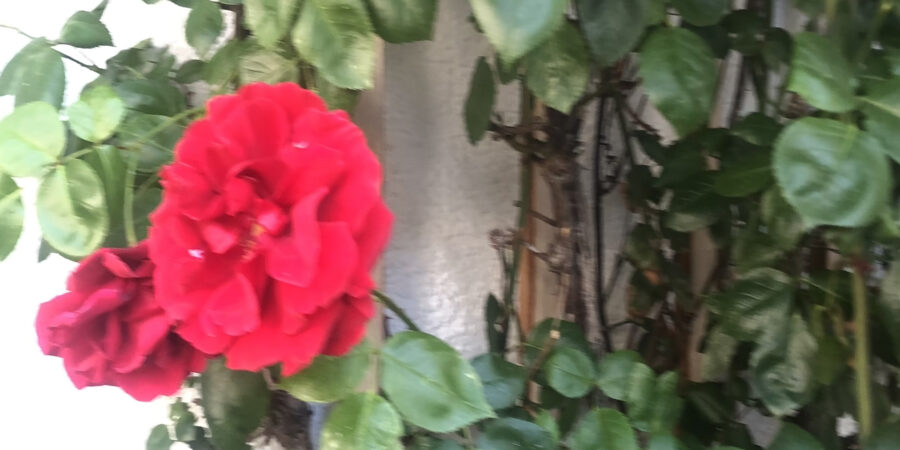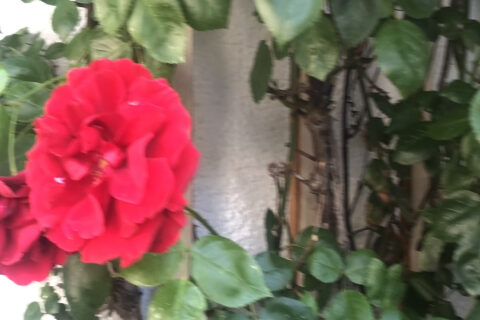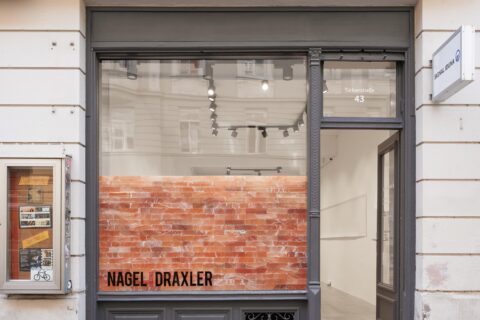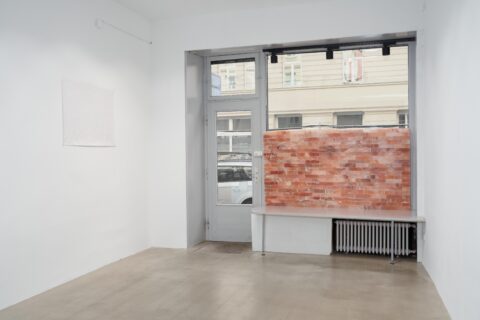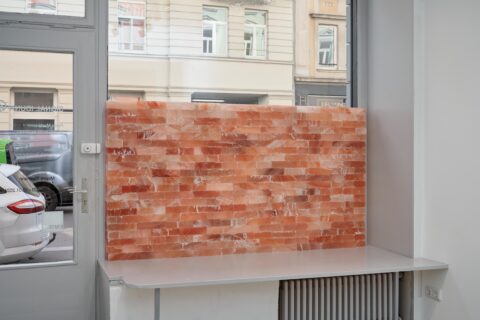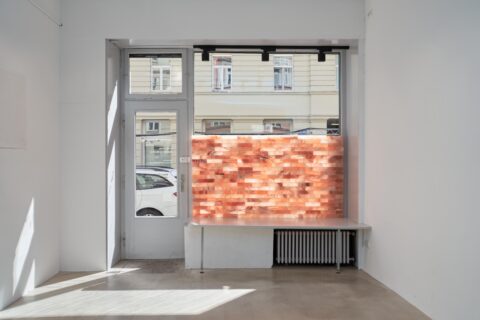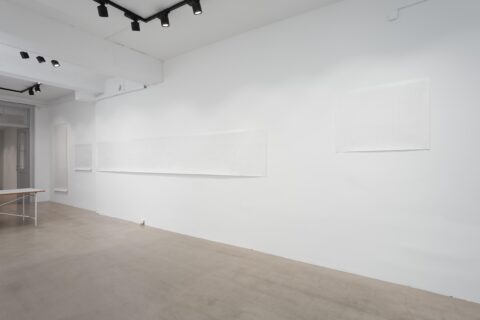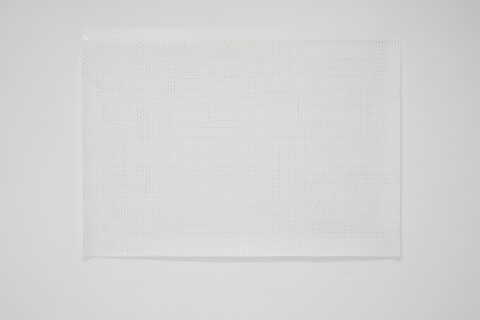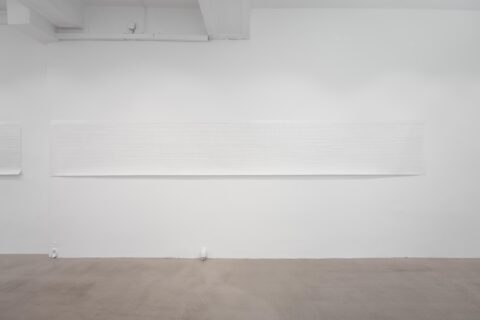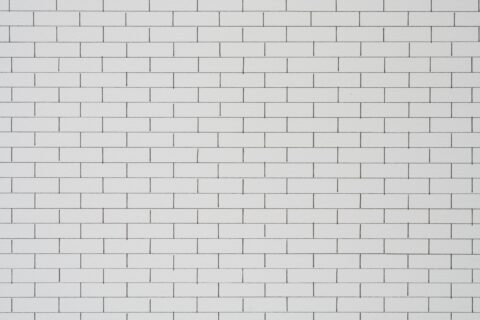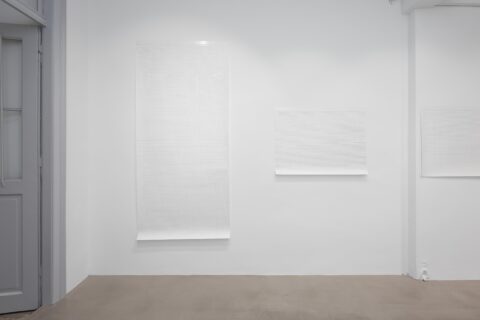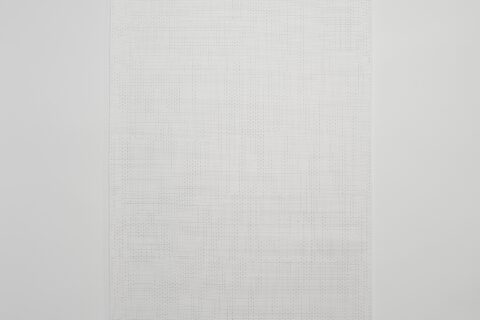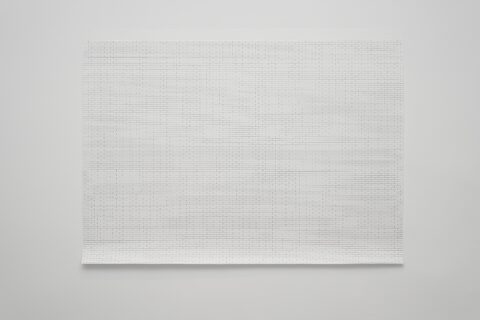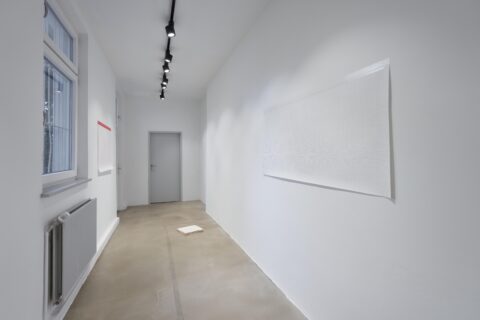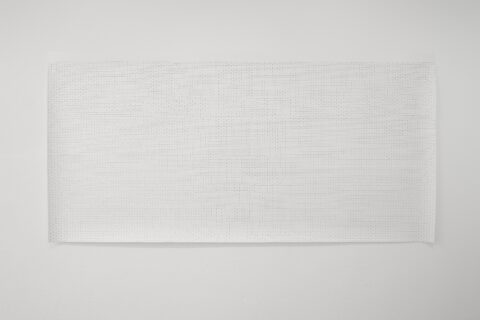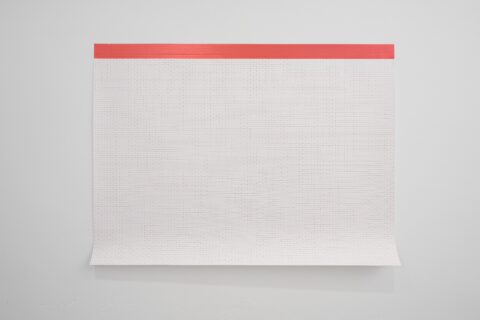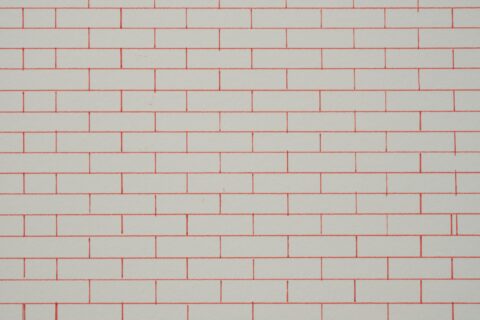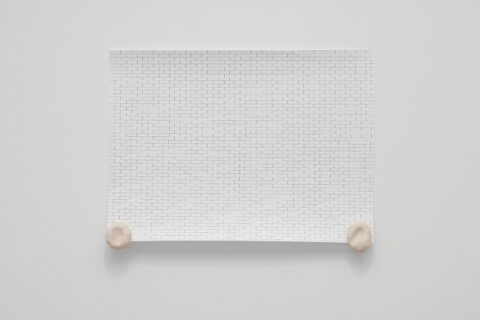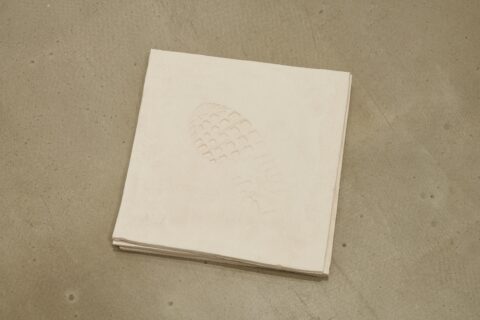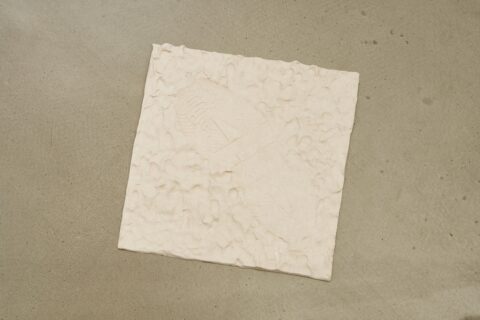Mirjam Thomann Alliance
09/09/2023 – 13/01/2024
Galerie Nagel Draxler
Türkenstraße 43
80799 München
Eröffnung: Freitag, 8. September 2023, 18-21 Uhr
Opening: Friday, September 8, 2023, 6-9pm
Verlängerte Öffnungszeiten während Various Others:
Samstag, 9. September 2023, 12-19 Uhr
Sonntag, 10. September 2023, 12-18 Uhr
Extended opening hours during Various Others:
Saturday, September 9, 2023, 12-7pm
Sunday, September 10, 2023, 12-6pm
Kontakt:
Peter Martin: +49 (0)172 8639 182
Press Release
** Please scroll down for the German version. **
Thomann´s Buildings
Mirjam Thomann´s newest series “Wall” (2023) consists of variously formatted large-scale drawings, meticulously drawn by hand. Countless lines form blocks and their proportion and pattern reveal them to be bricks. Bricks are laid in courses and the patterns are known as bonds, and Thomann’s bricks, too, build towards signification, doing so in a nearly universal and ancient architectural language.
In his dialogue with his son, Augustin of Hippo argues that you can point at the wall, but not at the three-syllables word pa-ri-es for the wall; so it’s “impossible to signify gesturally the components of a sign even if the sign is for something as concrete as a wall.”[i] Thomann´s “Wall” is a sign and it is concrete, and it does this by indexing the time its construction (brick by brick) takes, a laborious and repetitive process.
Renee Gladman writes and […] will mark her repeated return in this text.: “There had to be a secret society of people working on this invisible architecture. How could there not be? There were phantom structures being built on top of and in between ... what would you call them? Real structures, concrete structures?”[ii]
Installed so as to register and activate the latent organization of the gallery space, the drawings operate like sculptures. “Wall” adds a layer of abstraction that reveals the idea of the space and the calculability of the physical and disciplinary forces acting on it. Lodged between the intricate miniature scale of the bricks and the large format of the drawings, the viewer’s body is inevitably refracted, its proportions and position called into question.
“[…] here was my body, and it was with this body (enclosed in it) that I left the house that morning and it was with the same body that I returned.”[iii] And, “[…] I hoped to reach a point in speaking where when it was time to say ʻbodyʼ I could go silent instead.”[iv]
Thomann's drawings extrapolate a space inhabitable only by a body aligned with alterity, a body that knows of its fundamental improbability. A body made of bricks and in brackets: The coincidentally identic body is merely enclosed in a space also called the body. It’s tempting to think of that space as abstract and empty (minimalism may have done so), but it is blissfully overdetermined, all limb, awkward and teeming with the eponymous alliances, accidental and otherwise. Thomann´s spatial drawings return the exhibition space to a definitionally compromised and dependable state, indivisible from the bodies traversing it, outlining what needs are built in and which ones are painstakingly ignored.
“[…] architecture shatters into an interior revelation.”[v]
In “Interior Castle”, the 16th century mysticist Theresa von Avilas superimposes her journey to enlightenment onto seven successively arranged mansions. The rock-solid architecture of the metaphoric crystal-like castle is misleading though. With each mansion representing a different inner state, the architecture doesn´t separate which is already separated but that which needs separation. The problem is not distance but proximity, messiness, the familiar. The spatial organization is itself an effect of the meditation and introspection required, and the labor of orientation.
“[…] an interior revelation” or “[…], some place where a boundary has broken”[vi]
The second work in the space is “Window” (2022/2023), a site-specific installation that consists of multiple rows of salt bricks, stacked to obstruct most of the gallery´s front window. Flesh-colored and made from salt, the translucent wall simultaneously connects and separates inner and outer space. “Window” returns to this over-determined separation of spaces a fleshly density, something that invites the touch.
“[…] about the body I know very little though I am steadily trying to improve myself, in the way animals improve themselves by licking. I have always wanted to be sharp and clean.”[vii]
A space with and without a window recalls the legend behind the “Teufelstritt” at the nearby late Gothic – materially speaking, think bricks – cathedral Frauenkirche, a tailed footprint in bronze inserted into the church´s stone floor. According to legend, the footprint was left behind by a triumphant devil, who – from that particular position – could not see any windows. “Floor” (2023), the third series in the show, consists of three footprints of shoe soles in unglazed ceramics. Offering something like the inverse of the Early Renaissance central perspective, the work purposefully misaligns and multiplies perspectives, interpolating positioning and in extension orientation as something that’s virtually continuous and phenomenologically contingent. This includes the relationship between the exhibited works, that is rendered a specific effect of various delineated perspectives.
Whether the footprints were left behind by Thomann herself or someone else remains unclear; as a trace or marker, they suggest a continuation behind Thomann’s body and that of the viewer, undoing an exhausted distinction, and uncoupling the aesthetic experience from a sovereign subject (historically white, male and abled) position.
“[…] There continues to be a suggestion that we are somehow surrounded by other spaces in which exciting, ungraspable things occur.”[viii]
In Clarice Lispector´s “The Passion According to G.H.”, Lispector uses the last line of each chapter as the first line of the following chapter. The effect, according to Robert Glück, is that the focus is shifted away from the paragraph, and to the sentence, less narrative, more construction. Glück concludes: “ʻThe Passion According to G.H.ʼ finished me more than I finished it” – lines suggest their continuation.[ix] Alliance may well be understood in similar terms. The lines drawn by Thomann, whether those are drawn or lines of sight, model an architecture that’s irreducible to one position, immobilizing fantasies of ownership and completion, while generating the kind of spaces some of us find actually inhabitable because they only make sense when shared.
Christopher Weickenmeier
_____________________
[i] Earl Jackson, Jr., “Writing Internal Distances: Renee Gladman’s Translucent Poetics”, Tripwire (15), 2019, 127-128
[ii] Renee Gladman, Houses of Ravicka, (St. Louis: Dorothy Project, 2017), 122-123.
[iii] Renee Gladman, “The Sentence as a Space for Living: Prose Architecture”, Tripwire (15), 2019, 95.
[iv] Renee Gladman, Calamities, (Seattle/New York: Wave Books, 2016), 89.
[v] Bruna Mori, “Review of Houses of Ravicka”, Tripwire (15), 2019, 131.
[vi] Renee, Gladman, Houses of Ravicka, 100.
[vii] Gladman, “The Sentence as a Space for Living”, Tripwire (15), 2019, 92.
[viii] Ibid, 106.
[ix] Robert Glück, “The Passion According to G.H.”, Tripwire (15), 2019, 215.
_____________________
Thomann‘s Buildings
Mirjam Thomanns neueste Serie „Wall” (2023) besteht aus verschieden großformatigen, akribisch von Hand gefertigten Zeichnungen. Unzählige Linien bilden Blöcke, deren Proportionen und Muster sie als Ziegelsteine erkennen lassen. Ziegelsteine werden in Schichten verlegt und die Muster werden als Bindungen bezeichnet. Auch Thomanns Ziegelsteine schichten Bedeutung, und zwar in einer nahezu universellen, antiken architektonischen Sprache.
In einem Dialog mit seinem Sohn argumentiert Augustinus von Hippo, dass man zwar auf die Wand zeigen kann, aber nicht auf das dreisilbige Wort pa-ri-es für die Wand. Es ist „unmöglich gestisch auf die Komponenten eines Zeichens zu verweisen, selbst wenn es ein Zeichen für etwas so Konkretes wie eine Wand ist.”[i] Thomanns „Wall”-Zeichnungen sind Zeichen und sie sind konkret, indem sie die Zeit aufnehmen, die für deren Konstruktion benötigt wird, ein aufwendiger und repetitiver Prozess (Stein für Stein).
Renee Gladman schreibt und […] steht für ihre Wiederkehr in diesem Text: „There had to be a secret society of people working on this invisible architecture. How could there not be? There were phantom structures being built on top of and in between ... what would you call them? Real structures, concrete structures?”[ii]
So installiert, dass sie die latente Organisation des Galerieraums miteinbeziehen und aktivieren, fungieren die Zeichnungen wie Skulpturen. „Wall” fügt dem Raum eine Abstraktionsebene hinzu, die die Berechenbarkeit der physischen und disziplinierenden Kräfte, die auf ihn einwirken, offenlegt. Eingespannt zwischen dem komplexen Miniaturmaßstab der Ziegelsteine und dem Großformat der Zeichnungen wird der Körper der Betrachter*innen unweigerlich gebrochen, seine Proportionen und seine Position in Frage gestellt.
“[…] here was my body, and it was with this body (enclosed in it) that I left the house that morning and it was with the same body that I returned.”[iii] Und, “[…] I hoped to reach a point in speaking where when it was time to say ʻbodyʼ I could go silent instead.”[iv]
Thomanns Zeichnungen extrapolieren einen Raum, der nur von einem Körper bewohnt werden kann, der auf Alterität ausgerichtet ist, einem Körper, der um seine grundlegende Unwahrscheinlichkeit weiß. Ein Körper aus Ziegelsteinen und in Klammern: Der zufällig identische Körper ist lediglich in einem Raum eingeschlossen, der ebenfalls Körper heißt. Es liegt nahe, sich diesen Raum abstrakt und leer vorzustellen (der Minimalismus mag das getan haben), aber es ist ein überdeterminierter und unbeholfener Raum, ganz Gliedmaßen, animiert von den titelgebenden Allianzen, zufälliger Art oder nicht. Thomanns räumliche Zeichnungen versetzen den Ausstellungsraum in einen definitionsgemäß beeinträchtigten und unselbstständigen Zustand, untrennbar von den Körpern, die ihn durchqueren, und skizzieren, welche Bedürfnisse in ihn eingebaut sind und welche mühsam ignoriert werden.
“[…] architecture shatters into an interior revelation.”[v]
In „Die innere Burg” überträgt die Mystikerin Theresa von Avilas aus dem 16. Jahrhundert ihre Reise zur inneren Erleuchtung auf sieben aufeinander folgende Gemächer. Die felsenfeste Architektur der metaphorischen, kristallartigen Burg ist jedoch irreführend. Da jedes Gemach für einen anderen inneren Zustand steht, trennt die Architektur nicht das, was bereits getrennt ist, sondern das, was der Trennung bedarf. Das Problem ist nicht die Distanz, sondern die Nähe, die Unordnung, das Vertraute. Die räumliche Organisation ist nicht die Ursache sondern die Wirkung der notwendigen Meditation und Introspektion, sowie der unaufhörlichen Arbeit der Orientierung im inneren und äußeren Raum.
„ […] an interior revelation” or “[…], some place where a boundary has broken”[vi]
Die zweite Arbeit im Raum ist „Window“ (2022/2023), eine ortsspezifische Installation, die aus mehreren Reihen von Salzziegeln besteht, die so gestapelt sind, dass sie den größten Teil der Fensterfront der Galerie verdecken. Fleischfarbend und aus Salzstein gefertigt, verbindet und trennt die durchscheinende Wand gleichzeitig den Innen- und Außenraum. „Window“ gibt dieser überdeterminierten Raumtrennung eine fleischliche Dichte zurück, etwas, das die Berührung mitmeint.
„ […] about the body I know very little though I am steadily trying to improve myself, in the way animals improve themselves by licking. I have always wanted to be sharp and clean.”[vii]
Ein Raum mit und ohne Fenster erinnert an die Legende vom „Teufelstritt“ in der nahegelegenen spätgotischen Frauenkirche, ein Fußabdruck mit Sporn aus Bronze, der in den Steinboden der Kirche eingelassen ist. Die Legende besagt, dass der Fußabdruck von einem triumphierenden Teufel zurückgelassen wurde, der von dieser Position aus keine Seitenfenster sehen konnte. „Floor“ (2023), die dritte Serie der Ausstellung, besteht aus drei Fußabdrücken von Schuhsohlen in unglasierter Keramik. Die Arbeit vollzieht so etwas wie die Umkehrung der Zentralperspektive der Frührenaissance. Sie verschiebt und vervielfältig absichtlich die Perspektiven und interpoliert die Positionierung, um in der Folge Orientierung als etwas kontinuierliches und phänomenologisch kontingentes zu verstehen. Dazu gehört auch die Beziehung zwischen den ausgestellten Werken, die als spezifischer Effekt verschiedener abgegrenzter Perspektiven erkennbar wird.
Ob die Fußabdrücke von Thomann selbst oder von jemand anderem hinterlassen wurden, bleibt unklar. Als Spur oder Markierung suggerieren sie eine Fortsetzung zwischen Thomanns Körper und dem der Betrachter*innen, unterlaufen die historisch leergelaufene Unterscheidung, und entkoppeln die ästhetische Erfahrung von einer souveränen (historisch weißen, männlichen und abled) Subjektposition.
„ […] There continues to be a suggestion that we are somehow surrounded by other spaces in which exciting, ungraspable things occur.”[viii]
In Clarice Lispectors „The Passion According to G.H.” sind die letzten Zeilen eines jeden Kapitels und die ersten Zeilen des folgenden Kapitels identisch. Der Effekt, so Robert Glück, besteht darin, dass sich der Fokus vom Absatz auf den Satz verlagert, weniger auf die Erzählung, mehr auf ihre Konstruktion. Nochmal Glück: „ ʻThe Passion According to G.H.ʼ finished me more than I finished it” – Linien deuten auf Kontinuität.[ix] Alliance lässt sich durchaus ähnlich verstehen. Die von Thomann gezogenen Linien, seien es gezeichnete oder Blicklinien, modellieren eine Architektur, die sich nicht auf eine Position reduzieren lässt, die Besitz- und Vollendungsphantasien außer Kraft setzt und gleichzeitig die Art von Räumen schafft, die manche von uns tatsächlich bewohnbar finden, weil sie nur dann Sinn ergeben, wenn sie geteilt werden.
Christopher Weickenmeier
_____________________
[i] Earl Jackson, Jr., “Writing Internal Distances: Renee Gladman’s Translucent Poetics”, Tripwire (15), 2019, 127-128. [eigene Übersetzung]
[ii] Renee Gladman, Houses of Ravicka, (St. Louis: Dorothy Project, 2017), 122-123.
[iii] Renee Gladman, “The Sentence as a Space for Living: Prose Architecture”, Tripwire (15), 2019, 95.
[iv] Renee Gladman, Calamities, (Seattle/New York: Wave Books, 2016), 89.
[v] Bruna Mori, “Review of Houses of Ravicka”, Tripwire (15), 2019, 131.
[vi] Renee, Gladman, Houses of Ravicka, 100.
[vii] Gladman, “The Sentence as a Space for Living”, Tripwire (15), 2019, 92.
[viii] Ibid, 106.
[ix] Robert Glück, “The Passion According to G.H.”, Tripwire (15), 2019, 215.
